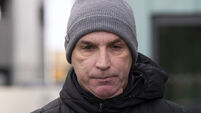Patrick Kelly: The road is long and hard, but I think this Cork group will make strides

CROWDED HOUSE: Cork’s Brian Hurley with Jonny Cooper and Eoin Murchan of Dublin in Saturday's All-Ireland SFC quarter-final at Croke Park. Picture: INPHO/Evan Treacy
A statistic to start off with; Cork’s combined first half tally against Kerry and Dublin this summer reads: scored 14, conceded 19. Not bad considering the opposition. However, the second half combined tally tells the full story; Cork scored seven points, conceded 25 points. Where did it all go wrong? Conditioning is too easy an out, tactics play a big part.
After conceding nine goals across seven division two league games, which included a goal in every game, Cork’s response was to employ Seán Powter as a sweeper to occupy the D and eliminate the threat of goals for the championship campaign. Indeed, it is bizarre that in 11 competitive games Cork played this year they only kept a clean sheet twice; against Kerry and Dublin. The big difference in those two games was that Cork sacrificed an attacker and essentially played with seven full-time defenders. The knock-on effect is huge, and I’ll try to explain why.
Firstly, opposition kickouts. I wrote prior to the game how Limerick won all 29 of their own kickouts and that I expected similar stats for Evan Comerford. He didn’t disappoint with Dublin winning all 23 of their own reststarts. This is a direct result of the permanent placing of Powter inside his own D and operating with five attackers.
Cork had seven attempts from dead balls which should at least have given an opportunity to press up man for man. Cork were unlucky on a few occasions with breaks and one fine fetch from Niall Scully near the sideline which resulted in a Dublin score.
This constant supply of possession meant Dublin kept coming at Cork with an extra man around the middle ensuring possession was nearly always kept secure. Their patience and ball handling in working scores is impressive as they stick to the process and rarely try anything off the cuff or risky. Powter was one of Cork’s standout players in their previous three outings as all three opponents played ball into his area or took on their men before being met by Powter with a double up. Dublin were too cute for that. They kept things simple and played on the outside of Cork with give and go passing and angled runs doing the damage. They stretched the pitch with width and depth, probed the wings and corners before injecting pace in the central area outside the D. Brian Fenton and Lee Gannon got two apiece highlighting this pattern of their play.
Another aspect of the game that became an issue for Cork was their own kickout. The game began brilliantly in this regard with Micheál Martin getting three short kickouts off in the first five minutes. Things changed however as Dublin began to press up aggressively and force Martin to go long. To be fair to Cork I felt the execution and placement of the kick was excellent with Cork having numbers under the dropping ball most of the time. Over time though Dublin began to dominate and won seven of Cork’s long kickouts adding to the wave of pressure on the Cork backs.
Cork’s first score of the second half came from John O’Rourke in the 56th minute. The 21 preceding minutes was where the game drifted from Cork. I do think the pattern of the first half had a big part to play in this. Dublin with their guaranteed possession from their own kickouts meant Cork spent most of the game chasing. Dublin’s conservative style in possession meant the level of concentration required and the effort to chase every run took its toll on Cork. It was clear from early in the second half that the energy was gone from Cork. That shouldn’t take away from their outstanding first half performance.
Cork’s dangerous full forward line of Brian Hurley (twice), Cathail O’Mahony and Stephen Sherlock all showed their class inside the first 22 minutes with fine scores from play. They wouldn’t, however, manage to score from play for the remainder of the game which tells its own story. Both Eoghan McSweeney and John O’Rourke kicked fine scores from play later which meant that all five starting forwards scored from play. This is very important as to move up the levels Cork will need to ensure that there is a spread of scores throughout the team and not become overly reliant on the inside line.
Reviewing the year is a difficult one. Home victories over Louth and Limerick are hardly anything to shout too loudly about. Nor are double digit defeats to both Kerry and Dublin. There must be context, however. After five league games and just a solitary point it was looking like Cork would be plying their trade this summer in the Tailteann Cup. Instead it ends with a creditable display against Dublin in Croke Park.
Looking ahead to next year Cork football must certainly start to look up and aim to make progress. The presence of Dublin, Derry and to a lesser extent Kildare, in Division Two makes promotion to Division One a tall order. Cork should however be closer to the promotion race than relegation battle and hopefully in a position to challenge for promotion in 2024. The turnover of players we saw from last year to this was on a scale I don’t think I’ve seen in Cork. Added to our dire injury situation and it has meant a lot of new faces have been blooded with plenty of cause for optimism.
Cork must only look to the other red and white team in Croke Park on Saturday for inspiration. Just three years ago the Oak Leaf County had slipped to Division 4 football, now they are only 70 minutes away from an All-Ireland final. The road is long and hard, but I think this group will make strides. Saturday was a taster of the big days, that can fuel a winter of hard work.







